Cross-Cultural Management Report: Hofstede's Model and USEM Model
VerifiedAdded on 2023/01/11
|7
|1690
|97
Report
AI Summary
This report examines the challenges of cross-cultural management through a case study involving Hydro Generation (HG) and its project in Tanzania. The report analyzes the cultural differences between the US-based HG and Tanzanian business practices, highlighting the dilemma faced by a vice president regarding an employee's approach to the project. It applies Hofstede's cultural dimensions model to understand cultural differences and the USEM model to evaluate employee employability. The report also reflects on the importance of teamwork and group dynamics in achieving project success, emphasizing the benefits of diverse perspectives and the acquisition of new skills. It concludes by emphasizing the importance of applying relevant theories to solve critical management issues and make informed decisions in cross-cultural contexts.

Cross Cultural
Management
Management
Paraphrase This Document
Need a fresh take? Get an instant paraphrase of this document with our AI Paraphraser
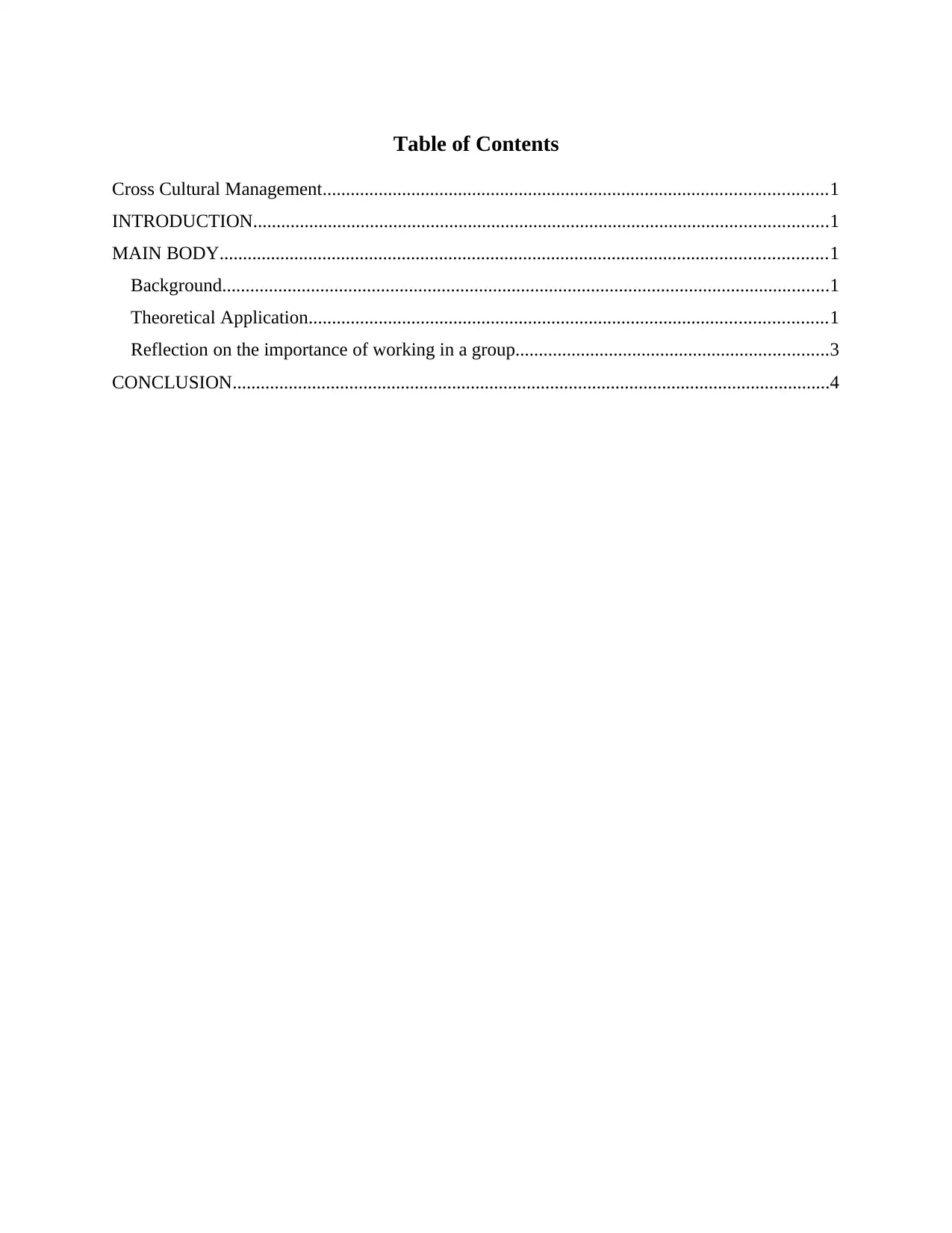
Table of Contents
Cross Cultural Management............................................................................................................1
INTRODUCTION...........................................................................................................................1
MAIN BODY..................................................................................................................................1
Background..................................................................................................................................1
Theoretical Application...............................................................................................................1
Reflection on the importance of working in a group...................................................................3
CONCLUSION................................................................................................................................4
Cross Cultural Management............................................................................................................1
INTRODUCTION...........................................................................................................................1
MAIN BODY..................................................................................................................................1
Background..................................................................................................................................1
Theoretical Application...............................................................................................................1
Reflection on the importance of working in a group...................................................................3
CONCLUSION................................................................................................................................4
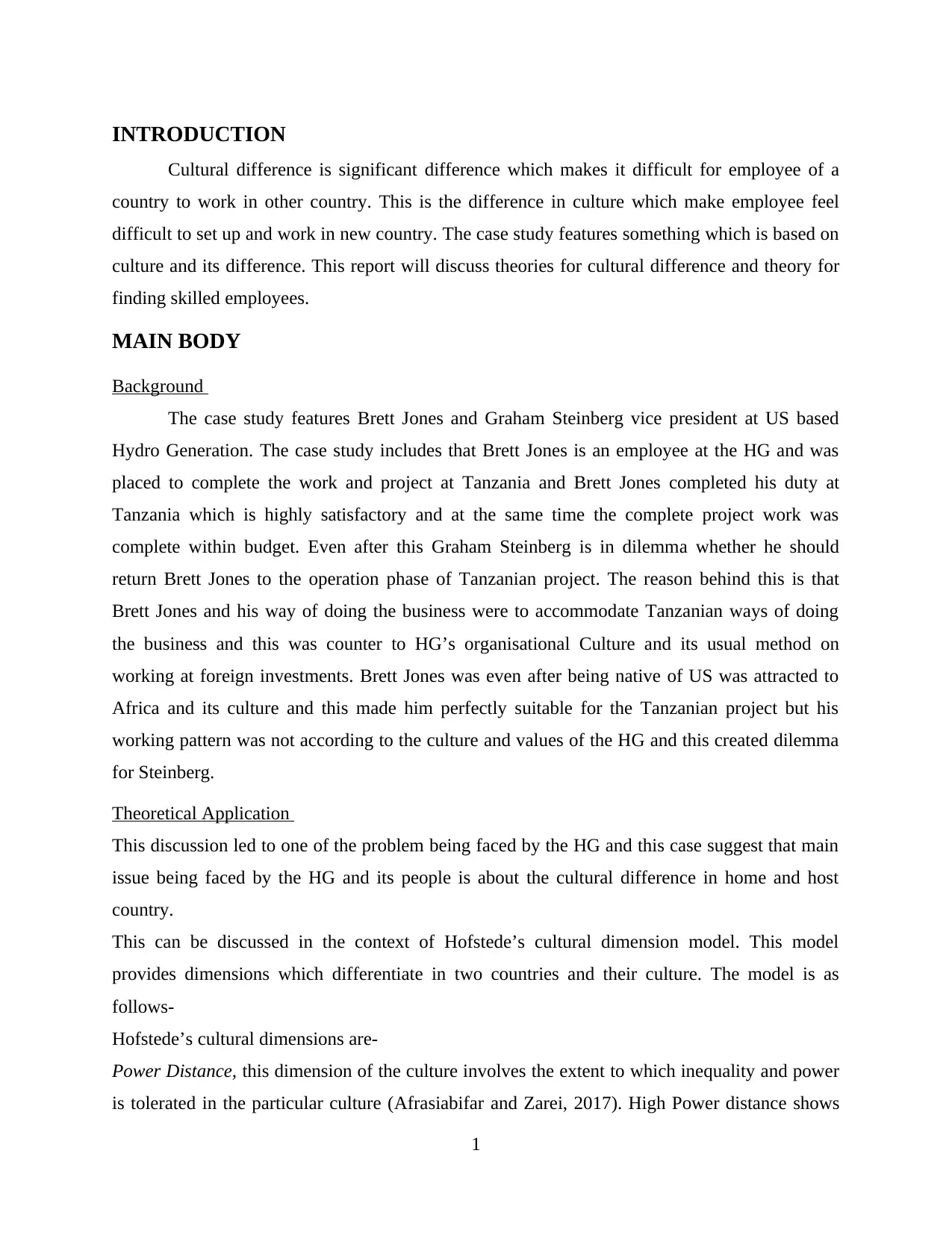
INTRODUCTION
Cultural difference is significant difference which makes it difficult for employee of a
country to work in other country. This is the difference in culture which make employee feel
difficult to set up and work in new country. The case study features something which is based on
culture and its difference. This report will discuss theories for cultural difference and theory for
finding skilled employees.
MAIN BODY
Background
The case study features Brett Jones and Graham Steinberg vice president at US based
Hydro Generation. The case study includes that Brett Jones is an employee at the HG and was
placed to complete the work and project at Tanzania and Brett Jones completed his duty at
Tanzania which is highly satisfactory and at the same time the complete project work was
complete within budget. Even after this Graham Steinberg is in dilemma whether he should
return Brett Jones to the operation phase of Tanzanian project. The reason behind this is that
Brett Jones and his way of doing the business were to accommodate Tanzanian ways of doing
the business and this was counter to HG’s organisational Culture and its usual method on
working at foreign investments. Brett Jones was even after being native of US was attracted to
Africa and its culture and this made him perfectly suitable for the Tanzanian project but his
working pattern was not according to the culture and values of the HG and this created dilemma
for Steinberg.
Theoretical Application
This discussion led to one of the problem being faced by the HG and this case suggest that main
issue being faced by the HG and its people is about the cultural difference in home and host
country.
This can be discussed in the context of Hofstede’s cultural dimension model. This model
provides dimensions which differentiate in two countries and their culture. The model is as
follows-
Hofstede’s cultural dimensions are-
Power Distance, this dimension of the culture involves the extent to which inequality and power
is tolerated in the particular culture (Afrasiabifar and Zarei, 2017). High Power distance shows
1
Cultural difference is significant difference which makes it difficult for employee of a
country to work in other country. This is the difference in culture which make employee feel
difficult to set up and work in new country. The case study features something which is based on
culture and its difference. This report will discuss theories for cultural difference and theory for
finding skilled employees.
MAIN BODY
Background
The case study features Brett Jones and Graham Steinberg vice president at US based
Hydro Generation. The case study includes that Brett Jones is an employee at the HG and was
placed to complete the work and project at Tanzania and Brett Jones completed his duty at
Tanzania which is highly satisfactory and at the same time the complete project work was
complete within budget. Even after this Graham Steinberg is in dilemma whether he should
return Brett Jones to the operation phase of Tanzanian project. The reason behind this is that
Brett Jones and his way of doing the business were to accommodate Tanzanian ways of doing
the business and this was counter to HG’s organisational Culture and its usual method on
working at foreign investments. Brett Jones was even after being native of US was attracted to
Africa and its culture and this made him perfectly suitable for the Tanzanian project but his
working pattern was not according to the culture and values of the HG and this created dilemma
for Steinberg.
Theoretical Application
This discussion led to one of the problem being faced by the HG and this case suggest that main
issue being faced by the HG and its people is about the cultural difference in home and host
country.
This can be discussed in the context of Hofstede’s cultural dimension model. This model
provides dimensions which differentiate in two countries and their culture. The model is as
follows-
Hofstede’s cultural dimensions are-
Power Distance, this dimension of the culture involves the extent to which inequality and power
is tolerated in the particular culture (Afrasiabifar and Zarei, 2017). High Power distance shows
1
⊘ This is a preview!⊘
Do you want full access?
Subscribe today to unlock all pages.

Trusted by 1+ million students worldwide
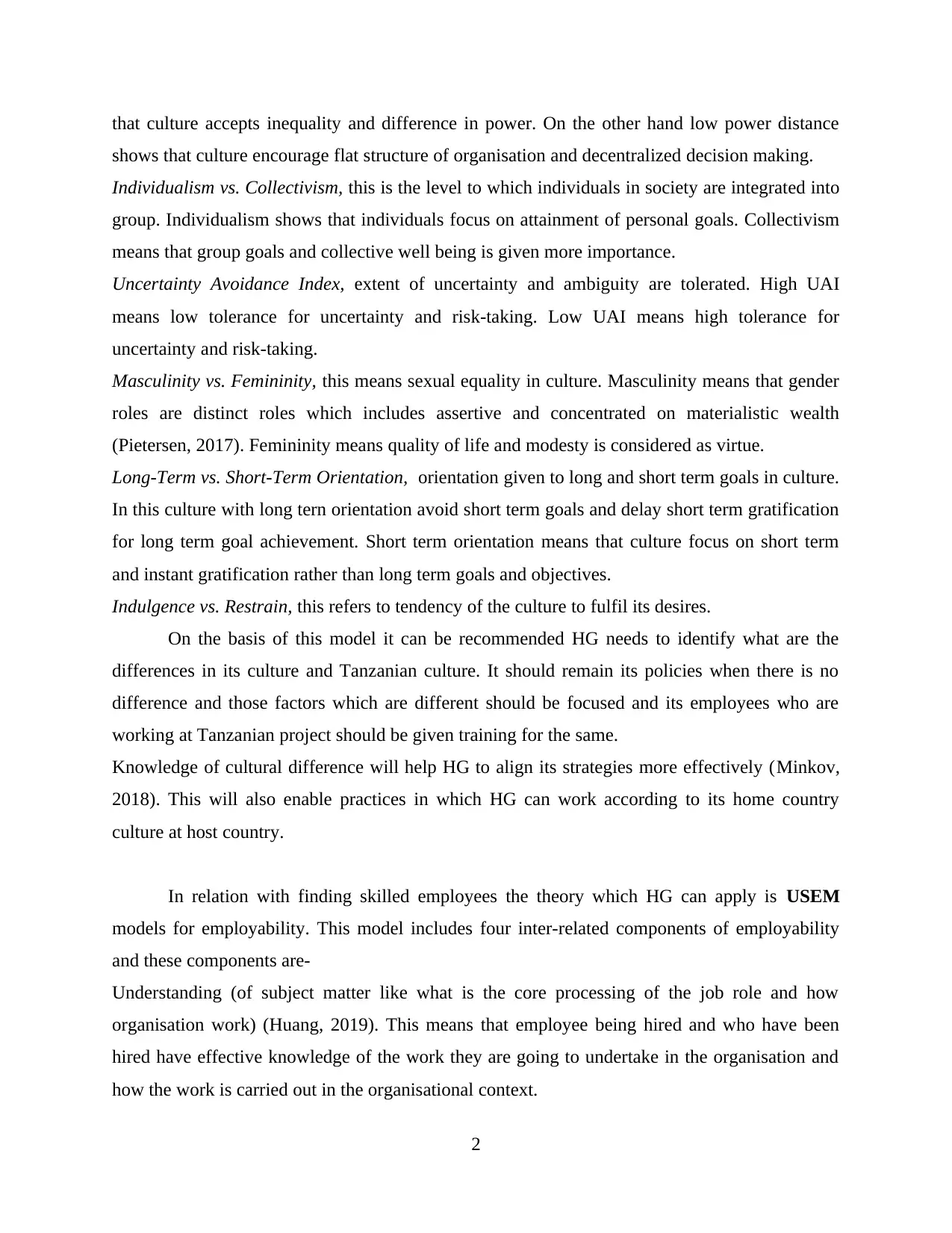
that culture accepts inequality and difference in power. On the other hand low power distance
shows that culture encourage flat structure of organisation and decentralized decision making.
Individualism vs. Collectivism, this is the level to which individuals in society are integrated into
group. Individualism shows that individuals focus on attainment of personal goals. Collectivism
means that group goals and collective well being is given more importance.
Uncertainty Avoidance Index, extent of uncertainty and ambiguity are tolerated. High UAI
means low tolerance for uncertainty and risk-taking. Low UAI means high tolerance for
uncertainty and risk-taking.
Masculinity vs. Femininity, this means sexual equality in culture. Masculinity means that gender
roles are distinct roles which includes assertive and concentrated on materialistic wealth
(Pietersen, 2017). Femininity means quality of life and modesty is considered as virtue.
Long-Term vs. Short-Term Orientation, orientation given to long and short term goals in culture.
In this culture with long tern orientation avoid short term goals and delay short term gratification
for long term goal achievement. Short term orientation means that culture focus on short term
and instant gratification rather than long term goals and objectives.
Indulgence vs. Restrain, this refers to tendency of the culture to fulfil its desires.
On the basis of this model it can be recommended HG needs to identify what are the
differences in its culture and Tanzanian culture. It should remain its policies when there is no
difference and those factors which are different should be focused and its employees who are
working at Tanzanian project should be given training for the same.
Knowledge of cultural difference will help HG to align its strategies more effectively (Minkov,
2018). This will also enable practices in which HG can work according to its home country
culture at host country.
In relation with finding skilled employees the theory which HG can apply is USEM
models for employability. This model includes four inter-related components of employability
and these components are-
Understanding (of subject matter like what is the core processing of the job role and how
organisation work) (Huang, 2019). This means that employee being hired and who have been
hired have effective knowledge of the work they are going to undertake in the organisation and
how the work is carried out in the organisational context.
2
shows that culture encourage flat structure of organisation and decentralized decision making.
Individualism vs. Collectivism, this is the level to which individuals in society are integrated into
group. Individualism shows that individuals focus on attainment of personal goals. Collectivism
means that group goals and collective well being is given more importance.
Uncertainty Avoidance Index, extent of uncertainty and ambiguity are tolerated. High UAI
means low tolerance for uncertainty and risk-taking. Low UAI means high tolerance for
uncertainty and risk-taking.
Masculinity vs. Femininity, this means sexual equality in culture. Masculinity means that gender
roles are distinct roles which includes assertive and concentrated on materialistic wealth
(Pietersen, 2017). Femininity means quality of life and modesty is considered as virtue.
Long-Term vs. Short-Term Orientation, orientation given to long and short term goals in culture.
In this culture with long tern orientation avoid short term goals and delay short term gratification
for long term goal achievement. Short term orientation means that culture focus on short term
and instant gratification rather than long term goals and objectives.
Indulgence vs. Restrain, this refers to tendency of the culture to fulfil its desires.
On the basis of this model it can be recommended HG needs to identify what are the
differences in its culture and Tanzanian culture. It should remain its policies when there is no
difference and those factors which are different should be focused and its employees who are
working at Tanzanian project should be given training for the same.
Knowledge of cultural difference will help HG to align its strategies more effectively (Minkov,
2018). This will also enable practices in which HG can work according to its home country
culture at host country.
In relation with finding skilled employees the theory which HG can apply is USEM
models for employability. This model includes four inter-related components of employability
and these components are-
Understanding (of subject matter like what is the core processing of the job role and how
organisation work) (Huang, 2019). This means that employee being hired and who have been
hired have effective knowledge of the work they are going to undertake in the organisation and
how the work is carried out in the organisational context.
2
Paraphrase This Document
Need a fresh take? Get an instant paraphrase of this document with our AI Paraphraser
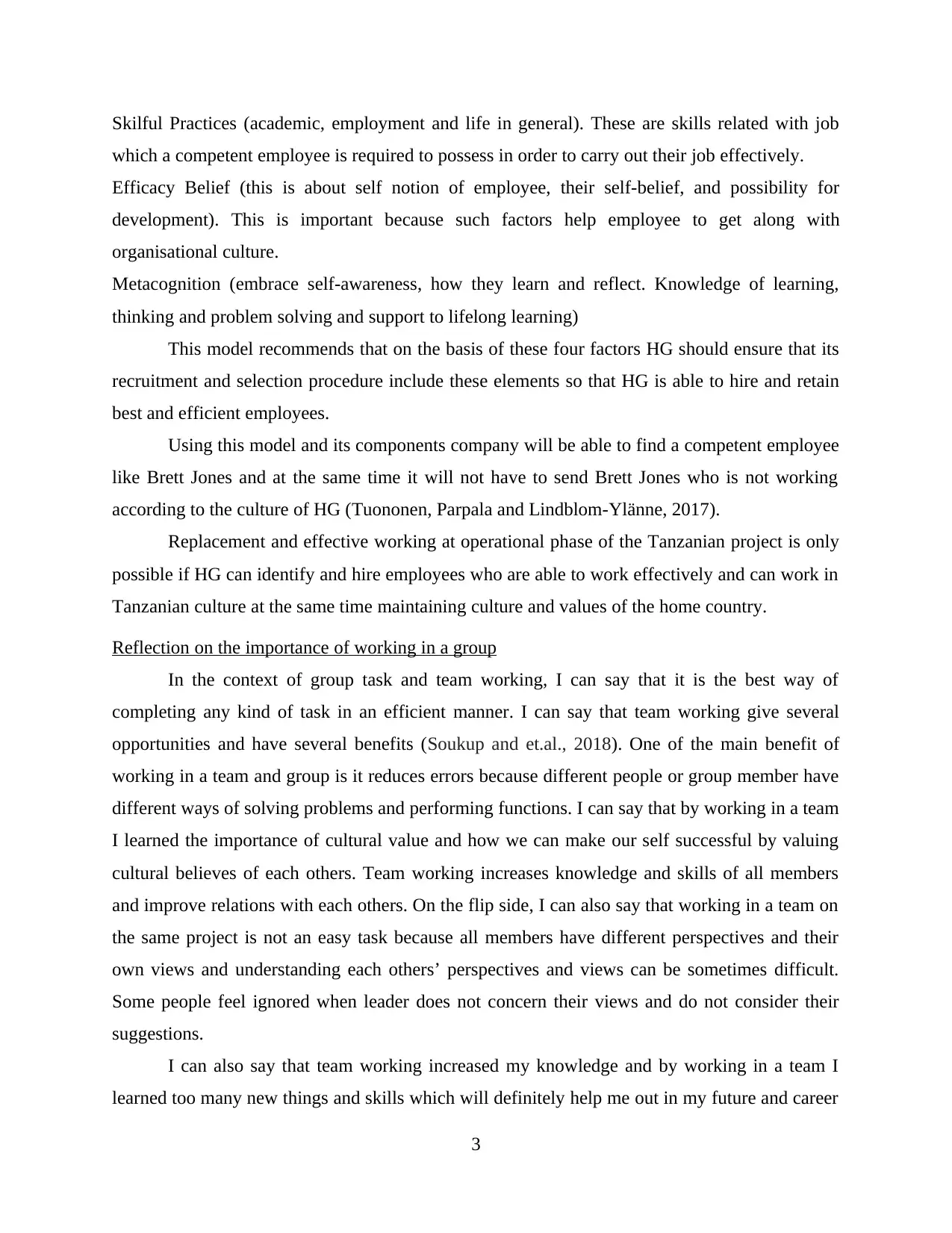
Skilful Practices (academic, employment and life in general). These are skills related with job
which a competent employee is required to possess in order to carry out their job effectively.
Efficacy Belief (this is about self notion of employee, their self-belief, and possibility for
development). This is important because such factors help employee to get along with
organisational culture.
Metacognition (embrace self-awareness, how they learn and reflect. Knowledge of learning,
thinking and problem solving and support to lifelong learning)
This model recommends that on the basis of these four factors HG should ensure that its
recruitment and selection procedure include these elements so that HG is able to hire and retain
best and efficient employees.
Using this model and its components company will be able to find a competent employee
like Brett Jones and at the same time it will not have to send Brett Jones who is not working
according to the culture of HG (Tuononen, Parpala and Lindblom-Ylänne, 2017).
Replacement and effective working at operational phase of the Tanzanian project is only
possible if HG can identify and hire employees who are able to work effectively and can work in
Tanzanian culture at the same time maintaining culture and values of the home country.
Reflection on the importance of working in a group
In the context of group task and team working, I can say that it is the best way of
completing any kind of task in an efficient manner. I can say that team working give several
opportunities and have several benefits (Soukup and et.al., 2018). One of the main benefit of
working in a team and group is it reduces errors because different people or group member have
different ways of solving problems and performing functions. I can say that by working in a team
I learned the importance of cultural value and how we can make our self successful by valuing
cultural believes of each others. Team working increases knowledge and skills of all members
and improve relations with each others. On the flip side, I can also say that working in a team on
the same project is not an easy task because all members have different perspectives and their
own views and understanding each others’ perspectives and views can be sometimes difficult.
Some people feel ignored when leader does not concern their views and do not consider their
suggestions.
I can also say that team working increased my knowledge and by working in a team I
learned too many new things and skills which will definitely help me out in my future and career
3
which a competent employee is required to possess in order to carry out their job effectively.
Efficacy Belief (this is about self notion of employee, their self-belief, and possibility for
development). This is important because such factors help employee to get along with
organisational culture.
Metacognition (embrace self-awareness, how they learn and reflect. Knowledge of learning,
thinking and problem solving and support to lifelong learning)
This model recommends that on the basis of these four factors HG should ensure that its
recruitment and selection procedure include these elements so that HG is able to hire and retain
best and efficient employees.
Using this model and its components company will be able to find a competent employee
like Brett Jones and at the same time it will not have to send Brett Jones who is not working
according to the culture of HG (Tuononen, Parpala and Lindblom-Ylänne, 2017).
Replacement and effective working at operational phase of the Tanzanian project is only
possible if HG can identify and hire employees who are able to work effectively and can work in
Tanzanian culture at the same time maintaining culture and values of the home country.
Reflection on the importance of working in a group
In the context of group task and team working, I can say that it is the best way of
completing any kind of task in an efficient manner. I can say that team working give several
opportunities and have several benefits (Soukup and et.al., 2018). One of the main benefit of
working in a team and group is it reduces errors because different people or group member have
different ways of solving problems and performing functions. I can say that by working in a team
I learned the importance of cultural value and how we can make our self successful by valuing
cultural believes of each others. Team working increases knowledge and skills of all members
and improve relations with each others. On the flip side, I can also say that working in a team on
the same project is not an easy task because all members have different perspectives and their
own views and understanding each others’ perspectives and views can be sometimes difficult.
Some people feel ignored when leader does not concern their views and do not consider their
suggestions.
I can also say that team working increased my knowledge and by working in a team I
learned too many new things and skills which will definitely help me out in my future and career
3
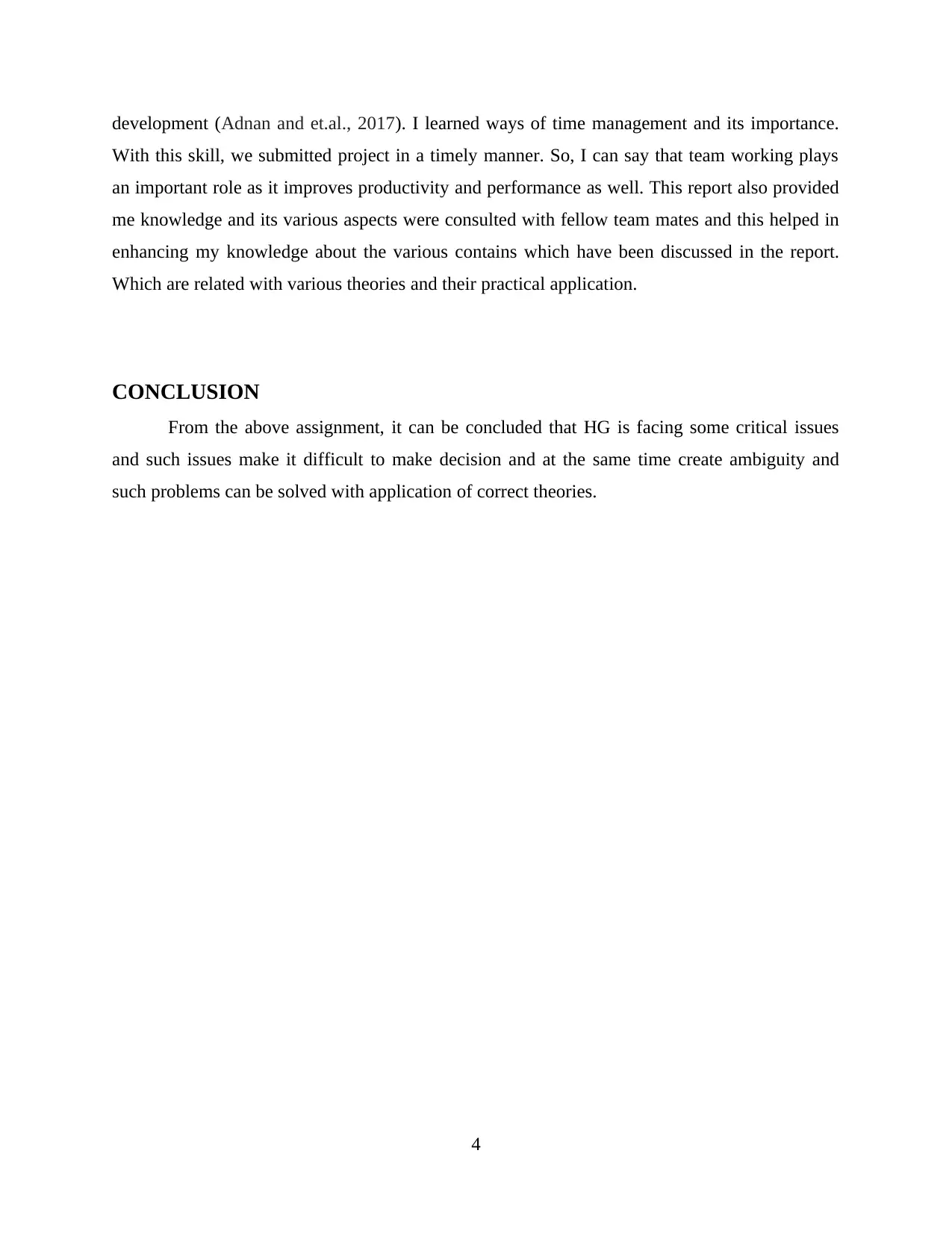
development (Adnan and et.al., 2017). I learned ways of time management and its importance.
With this skill, we submitted project in a timely manner. So, I can say that team working plays
an important role as it improves productivity and performance as well. This report also provided
me knowledge and its various aspects were consulted with fellow team mates and this helped in
enhancing my knowledge about the various contains which have been discussed in the report.
Which are related with various theories and their practical application.
CONCLUSION
From the above assignment, it can be concluded that HG is facing some critical issues
and such issues make it difficult to make decision and at the same time create ambiguity and
such problems can be solved with application of correct theories.
4
With this skill, we submitted project in a timely manner. So, I can say that team working plays
an important role as it improves productivity and performance as well. This report also provided
me knowledge and its various aspects were consulted with fellow team mates and this helped in
enhancing my knowledge about the various contains which have been discussed in the report.
Which are related with various theories and their practical application.
CONCLUSION
From the above assignment, it can be concluded that HG is facing some critical issues
and such issues make it difficult to make decision and at the same time create ambiguity and
such problems can be solved with application of correct theories.
4
⊘ This is a preview!⊘
Do you want full access?
Subscribe today to unlock all pages.

Trusted by 1+ million students worldwide
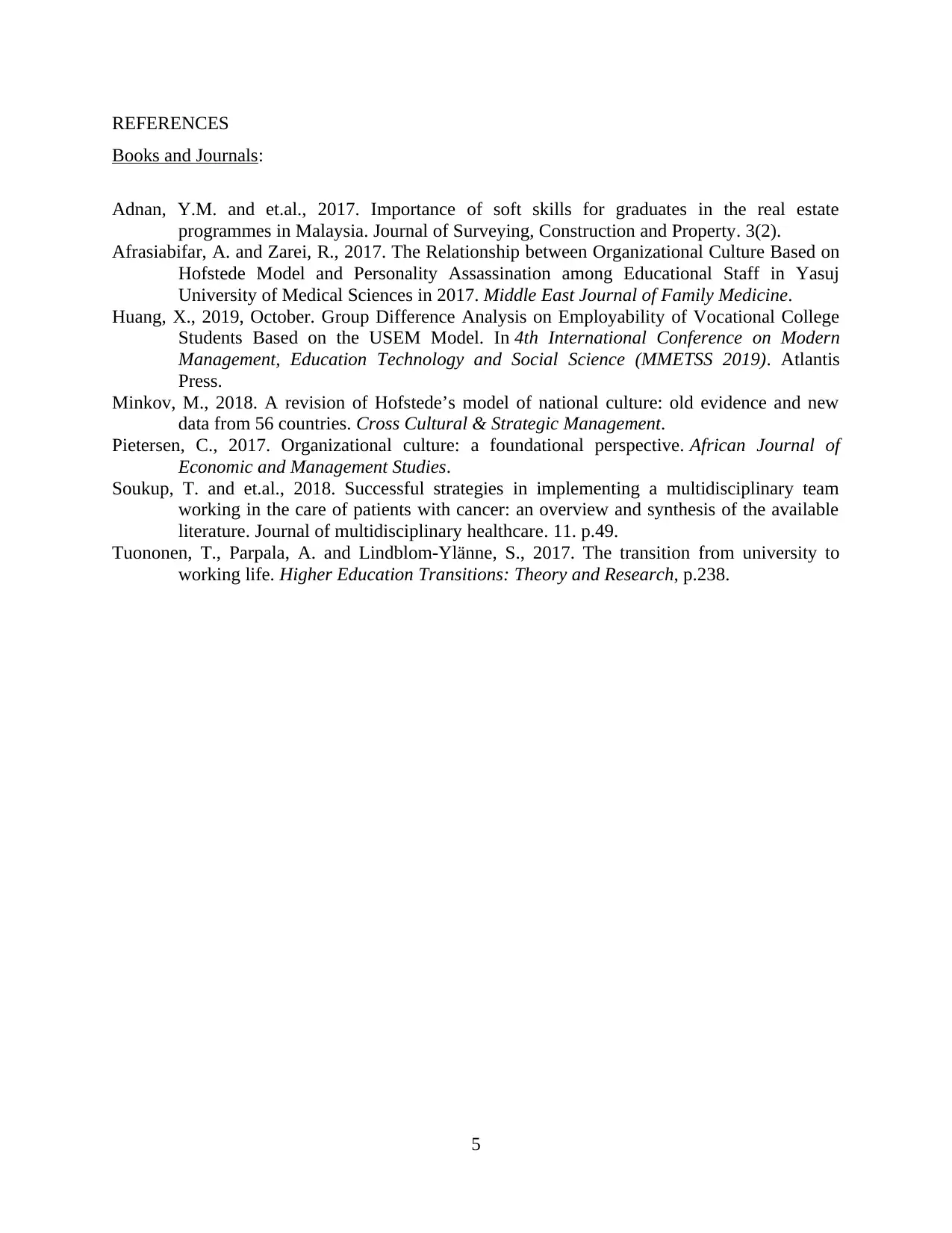
REFERENCES
Books and Journals:
Adnan, Y.M. and et.al., 2017. Importance of soft skills for graduates in the real estate
programmes in Malaysia. Journal of Surveying, Construction and Property. 3(2).
Afrasiabifar, A. and Zarei, R., 2017. The Relationship between Organizational Culture Based on
Hofstede Model and Personality Assassination among Educational Staff in Yasuj
University of Medical Sciences in 2017. Middle East Journal of Family Medicine.
Huang, X., 2019, October. Group Difference Analysis on Employability of Vocational College
Students Based on the USEM Model. In 4th International Conference on Modern
Management, Education Technology and Social Science (MMETSS 2019). Atlantis
Press.
Minkov, M., 2018. A revision of Hofstede’s model of national culture: old evidence and new
data from 56 countries. Cross Cultural & Strategic Management.
Pietersen, C., 2017. Organizational culture: a foundational perspective. African Journal of
Economic and Management Studies.
Soukup, T. and et.al., 2018. Successful strategies in implementing a multidisciplinary team
working in the care of patients with cancer: an overview and synthesis of the available
literature. Journal of multidisciplinary healthcare. 11. p.49.
Tuononen, T., Parpala, A. and Lindblom-Ylänne, S., 2017. The transition from university to
working life. Higher Education Transitions: Theory and Research, p.238.
5
Books and Journals:
Adnan, Y.M. and et.al., 2017. Importance of soft skills for graduates in the real estate
programmes in Malaysia. Journal of Surveying, Construction and Property. 3(2).
Afrasiabifar, A. and Zarei, R., 2017. The Relationship between Organizational Culture Based on
Hofstede Model and Personality Assassination among Educational Staff in Yasuj
University of Medical Sciences in 2017. Middle East Journal of Family Medicine.
Huang, X., 2019, October. Group Difference Analysis on Employability of Vocational College
Students Based on the USEM Model. In 4th International Conference on Modern
Management, Education Technology and Social Science (MMETSS 2019). Atlantis
Press.
Minkov, M., 2018. A revision of Hofstede’s model of national culture: old evidence and new
data from 56 countries. Cross Cultural & Strategic Management.
Pietersen, C., 2017. Organizational culture: a foundational perspective. African Journal of
Economic and Management Studies.
Soukup, T. and et.al., 2018. Successful strategies in implementing a multidisciplinary team
working in the care of patients with cancer: an overview and synthesis of the available
literature. Journal of multidisciplinary healthcare. 11. p.49.
Tuononen, T., Parpala, A. and Lindblom-Ylänne, S., 2017. The transition from university to
working life. Higher Education Transitions: Theory and Research, p.238.
5
1 out of 7
Related Documents
Your All-in-One AI-Powered Toolkit for Academic Success.
+13062052269
info@desklib.com
Available 24*7 on WhatsApp / Email
![[object Object]](/_next/static/media/star-bottom.7253800d.svg)
Unlock your academic potential
Copyright © 2020–2025 A2Z Services. All Rights Reserved. Developed and managed by ZUCOL.




